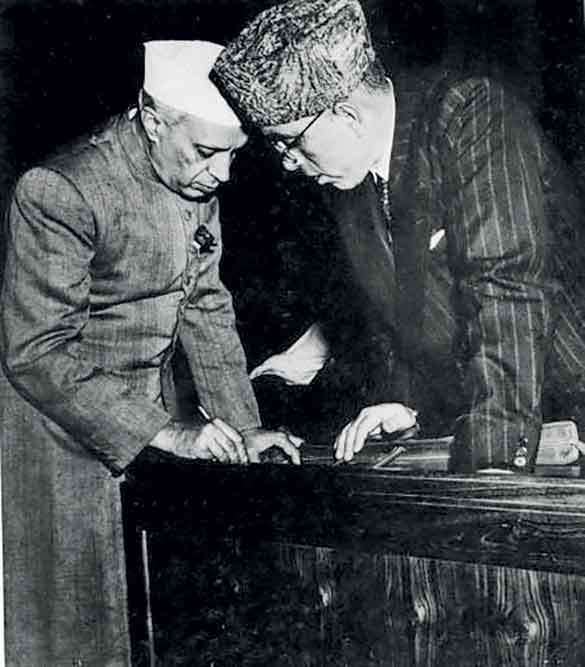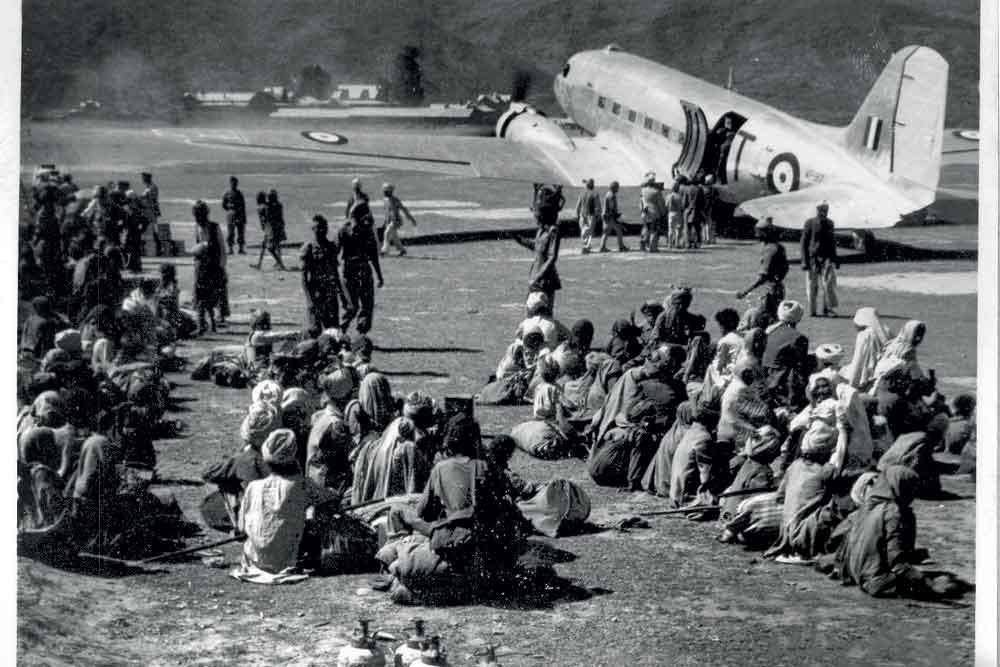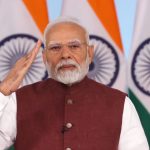Withering Away
The redundancy of the Dynasty and the trial of the Nehruvian legacy
 Rajeev Deshpande
Rajeev Deshpande
 Rajeev Deshpande
Rajeev Deshpande
 |
15 Dec, 2023
|
15 Dec, 2023
/wp-content/uploads/2023/12/Weatheringaway1.jpg)
(From L to R) Jawaharlal Nehru, Indira Gandhi, Rajiv Gandhi, Priyanka and Rahul Gandhi (Illustration: Saurabh Singh)
IT WAS A COINCIDENCE THAT Parliament passed two Bills, one to increase the effective strength of the Jammu and Kashmir (J&K) Assembly to 90 from 83 and provide for the nomination of two Kashmiri migrants and one displaced person from Pakistan-occupied Kashmir (PoK), and the other to facilitate reservation in jobs and admissions for Scheduled Castes (SCs) and Scheduled Tribes (STs) and other socially and educationally backward classes, on the same day the Supreme Court upheld the revocation of Article 370. As coincidences go, it was a fortuitous one with the action in Parliament and in the court turning the page on a contentious piece of history and delivering a long overdue course correction that fully and substantially integrates J&K with the rest of India. The play of coincidence does not, however, end with these momentous developments. The proceedings in Parliament and the Supreme Court came soon after watershed electoral results in three heartland states that are yet another blow to the inheritors of the thought that saw Article 370 as a political stratagem.
It was not a surprise that the passage of the legislation saw an acrimonious discussion on the events that followed Partition in 1947 and the role of Jawaharlal Nehru as India’s first prime minister. This was not particularly unexpected as Nehru has taken a bit of beating in recent years despite the efforts of Congress leaders and his other ideological defenders. This is, of course, due to the ascendance of the Bharatiya Janata Party (BJP), which had staunchly opposed Article 370, and the party’s current leadership which spares no punches in asserting that “Nehruvian blunders” are not a mere figure of speech but errors that imposed a heavy political and social cost on India. As Union Home Minister Amit Shah told Trinamool Congress’ (TMC) Saugata Roy in Lok Sabha, “Aap ki sehmati, nasehmati se kya hota hai, pura desh chahta tha [How does your concurrence or lack of it matter? The whole country wanted it (abrogation of Article 370)].” Shah rebutted the claim that BJP’s opposition to a separate flag, constitution and prime minister for J&K, energetically expressed by Bharatiya Jana Sangh founder Syama Prasad Mookerjee, was just a political slogan. The exchange crystallised the essence of two contending visions of India. Did the application of Article 370 to J&K lead to an accommodation (and protection) of Kashmiri interests in the India that was born on August 15, 1947? Did the special status it offered become central to the Delhi Agreement of 1952 concluded between Sheikh Abdullah and Nehru? Any review of J&K’s troubled past, where the Kashmir Valley, Ladakh and Jammu shared no common interests, a prolonged insurgency, long spells of Central rule, and a festering sense of alienation, is irrefutable evidence that the promised integration turned out to be a false dawn.
The debate on Nehru inevitably turns towards the decision to take the Kashmir dispute to the United Nations (UN) on January 1, 1948 and the ceasefire agreement between India and Pakistan. The failure of the UN to be a fair ombudsman and the internationalisation of the dispute to India’s disadvantage became apparent in no time. The UN Security Council (UNSC) disregarded evidence of Pakistan’s aggression, chose to treat victim and aggressor alike, and imposed a ceasefire which India and Pakistan formally signed in July 1949, resulting in the Line of Control (LoC). Shah’s assertion that going to the UN and agreeing to a ceasefire were “blunders” was challenged by the claim that Nehru acted on military advice against prolonging hostilities. Some commentators said the war had dragged on and there was a danger of it spilling onto other fronts and that the then-commander-in-chief of the Indian Army, General Roy Bucher, had argued for a ceasefire. This requires closer attention. An examination of papers in British records by the late Chandrashekhar Dasgupta, a veteran diplomat in his day, revealed that India’s former colonial masters did not want India to gain control of all of Kashmir as this militated against their geopolitical interests. His writing also brings out Nehru’s apparent impatience with British commanders and that on occasion information may have been withheld from him.

A more charitable view of the events of 1947-48 can be that the leadership of newly independent India was unsure about the role of great powers—not the least the UK—and the full consequences of war. But why Nehru should have relied so heavily on General Bucher’s view that the military situation was not tenable is unclear. The fighting did continue through 1948 and after considerable effort and sacrifice, Indian troops not only turned back invading Pakistani irregulars and troops but were poised to advance into what is today PoK. Late General KV Krishna Rao, who was Army chief and also governor of J&K, wrote: “Overall, it was because of (Army Commander) General KM Cariappa’s clarity of vision and determination, that the aim was largely fulfilled. In the initial stages though the enemy was knocking at the gates of Srinagar and was quite close to Jammu, by the end of the operations, he was driven well out from the bulk of the territory; and more than two-thirds of Jammu and Kashmir was retrieved.” Military historian and Air Vice Marshal (retired) Arjun Subramaniam explained how the offensive towards Mirpur, Kotli and Muzzafarabad never materialised. “This was not to be, as Mountbatten pushed Nehru and the Pakistani political leadership to accept a UN brokered ceasefire on 31 December, 1948, that left large portions of the Northern region, Kashmir Valley and Jammu Province in Pakistani hands. The military angle of this nudge was that had the Indian Army, supported by an increasingly confident Royal Indian Air Force, chosen to conduct their spring offensive along the Indus towards Gilgit and Skardu, the strategically important region may no longer have been a buffer that could be exploited by the British in the Great Game; a possibility, which they optimistically thought could be sustained for decades to come,” Subramaniam wrote.
There was an acrimonious discussion on the events that followed partition and the role of Jawaharlal Nehru as the first prime minister. This was not unexpected as Nehru has taken a beating in recent years despite the efforts of Congress leaders and his other ideological defenders
There is reason to believe Nehru’s view of himself as an internationalist did weigh disproportionately on his decisions. Even Lt General BM Kaul, who was close to Nehru, has written that the action to liberate Goa was delayed due to Nehru’s concerns about how this would play out internationally. This could have been a legitimate concern but there are times when decisive action is needed in the national interest. The Indian Army undertook bold and brave actions after Pakistani invaders entered J&K in 1947. Reasons can always be advanced in favour of the decision to accept a ceasefire but the self-belief required to seize the moment was absent. Nehru’s ‘mistakes’ did not end in 1948 but were repeated on a much more tragic scale in 1962 when India failed to read the intent of Chinese leader Mao Zedong until it was too late.
THE INTERNATIONALISATION OF the Kashmir dispute and the application of the provisions of Article 370 did nothing to integrate hearts and minds. Decades passed before the Modi government, on August 5, 2019, successfully steered through Parliament the nullification of the application of Article 370 to J&K. Much of the facts relating to the effects of the decision, including the suspicions of seditious activity that led to the dismissal of Sheikh Abdullah as ‘Prime Minister’ in 1953, and emotional disconnect between the Valley and the rest of India have been evident for long. Since the reins of power were in the hands of a Nehruvian order that dominated academia and cultural spheres, there was no acknowledgement of the errors, let alone any move to undo them. Rather, it was heresy to suggest as much. The turn of events since the Modi government won its second term in office—nullification of Article 370 (and Article 35-A that allowed J&K to frame discriminatory laws), reduction of the state to a Union territory (UT), and the investment of Ladakh as a separate UT—has been followed by serious political reverses for Congress. After returning to office in Himachal Pradesh in December 2022 and in Karnataka in May 2023, Congress faced a sterner test in Madhya Pradesh, Rajasthan, Chhattisgarh, Mizoram, and Telangana. It wrested Telangana but failed to make an impression elsewhere. The failures in the heartland and Northeast are hard to swallow as Congress leaders Rahul and Priyanka Gandhi campaigned promising to implement a slew of populist promises and hold a caste-based census along with attacking the Modi government for alleged acts of crony capitalism. With only Himachal providing a toehold in north India, the country’s oldest political dynasty faces a searing moment of truth. State polls have regional contexts but Congress lost a bigger battle, perhaps without quite realising it.

The sense of loss is now eviscerating. It is both a physical dislocation, as in the remaking of the Central Vista that will consign the socialist-inspired masonry of official Delhi to history, and also a radical undoing of the political belief system that has sustained Congress and its first family. Truth be told, the stress the party is experiencing has been evident for a while. The hasty adoption of a Mandalite agenda, the advocacy of fringe-leftist concerns, or the failure to denounce ally the Dravida Munnetra Kazhagam’s (DMK) insensitive remarks on Sanatana Dharma, all bespeak opportunism and drift in equal measure. There was something that Congress did do well in the past. It offered a please-all social contract to various sections, such as the middle class and the poor, promising a share of India’s growth dividend by way of economic opportunities and rights-based benefits. It seemed an equitable deal until growth dwindled and contradictions and the shortcomings of catering to sectional interests became unmanageable. The failed bid of the United Progressive Alliance (UPA) government to bring forward a bill to prevent communal violence, which held that only minorities could be victims of such violence, showed how deep the rot had set in. Guided by a set of politicised activists and self-professed advocates of minority rights, the Sonia Gandhi-led National Advisory Council (NAC) had drafted the divisive legislation which the Manmohan Singh government had to withdraw not only in the face of BJP’s opposition but also criticism from regional parties that it was violative of the federal structure.
The internationalisation of the Kashmir dispute and the application of the provisions of Article 370 did nothing to integrate hearts and minds. Decades passed before the Modi government, on August 5, 2019, successfully steered through parliament the nullification of the application of Article 370 to Kashmir
The rising dissatisfaction in various sections of society as also a gathering Hindu backlash propelled Narendra Modi to prime ministerial office in May 2014. The verdict was, however, not just a rejection of stale politics but embodied the hopes for an equitable, culturally rooted, and modern India. Despite the ups and downs of state elections, Modi has stayed the course, embracing a welfarism that is inclusive and blunts caste-oriented appeals. He has also moved fast to unleash wide-ranging reforms in almost all sectors of the economy to enable a higher spectrum of growth to generate jobs and skills on a scale that caters to rising aspirations. He keenly understands that the size of the pie must keep increasing and projects such as GIFT City and the Dholera Smart City in Gujarat showcase this vision. Congress finds itself ousted from the minds of both urban and rural voters. It cannot take refuge in arguments that only a little more than a 2 per cent vote share separated it from BJP in Rajasthan. Or that weaknesses in communication and BJP’s ability to ‘polarise’ voters have brought about its current woes. The party and dynasty face a vast trust deficit and are losing whatever hold they have had on the Indian imagination. Their chief backers comprise BJP’s ideological opponents and an echo-chamber that endorses the dynasty but, despite its disproportionate clout in elite circles, is unable to arrest the decline in Congress’ fortunes. Rather their advocacy more often convinces doubters and fence-sitters to move in the opposite direction. The Nehruvian project is not bereft of its advocates. But its principal ideological and ideational constructs are falling apart in the face of an uncluttered vision and political determination to pursue a different path.

/wp-content/uploads/2025/06/Cover-OpenMinds2025.jpg)












More Columns
Without govt aid, Musk will have to head back home to South Africa: Trump Open
Google Goes Nuclear Open
PM Modi marks 10 years of Digital India, highlights transformation Open